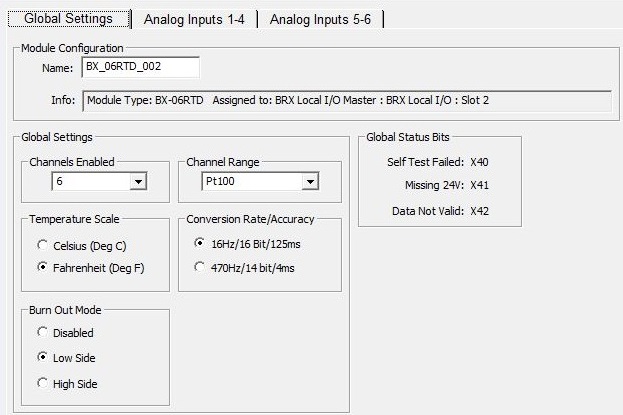Topic: DMD0443
Module Configuration for BX-06RTD Input Module
When a Do-more CPU powers up and detects a new BX-06RTD module it will automatically create a module configuration and assign the required I/O mapping using the first 6 available WX (32-bit signed integer) locations and first 24 available X (input bit) locations required by the module.
The default configuration has all of the channels enabled, expecting a Pt100 RTD, Degrees F, 16Hz Conversion rate, Burnout Enabled, and scaling disabled. Clicking the Edit Config button in the Module Configuration utility will open the following dialog where the default configuration can be changed.

The Global Settings tab for this module sets the following options that apply to the module as a whole, or to all of the channels on the module:
The Module Configuration group:
Name is a name assigned to the module, The default name is the module's part number followed by the slot number where it currently is located. The default name can be changed if required.
Info shows the part number, the number of the controlling I/O Master, and the slot number where the module is located.
The Global Settings group:
Channels Enabled selects how many of the available channels will have a probe attached. Channels are enabled in order starting with the first. Channels that are enabled WITHOUT having a probe installed will generate an error if the Burn Out Mode is enabled.
Temperature Scale selects the temperature scale the module will use when it provides temperature data to the PLC:
- Celsius (Dec C)
- Fahrenheit (Deg F)
Burn Out Mode selects what action to take if the RTD connected to an enabled channel either fails or is disconnected:
- Disabled means the channel's burnout bit will be NOT be turned ON and the channel's value should not be considered valid.
- Low Side means the channel's burnout bit will be turned ON and the channel's value will be set to the minimum raw value (-32768).
- High Side means the channel's burnout bit will be turned ON and the channel's value will be set to the maximum raw value (32767).
Channel Range selects the type of RTD or resistance range of the probe that will be connected to the channels on this module. All RTDs on this module must be the same type.
Conversion Rate / Accuracy selects slower response with more accurate data, or faster response with less accurate data.
- 16Hz / 16-bit / 125ms means 16Hz sample rate which generates a 16-bit value for a channel every 125ms.
- 470Hz / 14-bit / 4ms means 470Hz sample rate which generates a 14-bit value for a channel every 4ms.
The Global Status Bits group shows the X bit locations the module uses to indication module-wide errors:
Self Test Failed indicates the module did not pass its power-on self test.
Missing 24V indicates the required external 24 VDC power is not connected.
Data Not Valid indicates the proper module configuration was not written to the module at power-up, or that the module lost it's configuration at runtime (probably due to extreme noise), or that the input is out of range.

The Analog Inputs 1-4 and Analog Inputs 5-6 tabs set the following options that are specific to the individual channels:
Analog Input 1 selects the type of RTD that is attached to this channel, or selects one of the voltage input ranges
The WX# group shows the range of values, the Units / Count of the raw input value, and the X bit memory locations for the Data Out of Range and Burn Out indications. If the Input Type is one of the RTD selections, the raw data values for the channels are temperature values in tenths of degrees.
The RX# group (if automatic scaling is enabled for this channel) shows the Real numeric memory location where the scaled value will be stored in the CPU, the range of potential values and the Units / Count based on the current scale factors.
Note: if the Input Type is one of the RTD selections, the raw data values for the channels are already temperature values in tenths of degrees; this means scaling is NOT necessary to get a temperature value from the channels. However, one good use of the scaling option is to have the module automatically generate a Real (floating point) version of the raw input value by setting WX# Min / WX# Max values to -32768 and 32767 respectively, and setting RX# Min / RX# Max values to -3276.8 and 3276.7 respectively.
Enable Scaling from WX# to RX# enables the automatic scaling of the raw input value (32-bit signed integer) to engineering units (32-bit real).
WX# Min / WX# Max the minimum and maximum raw values determined by the Analog Input # selection.
Counts / Deg (F/C) displays the WX#'s Min and Max values in terms of the range of counts or the range of Degrees (Fahrenheit or Celsius).
RX# Min / RX# Max contains the minimum and maximum values for the engineering units.
Clamp RX# (if enabled) and the calculated scaled value is lower than RX # Min or higher than RX# Max, the specified Min and Max values will be used.
